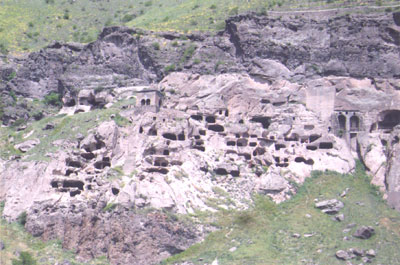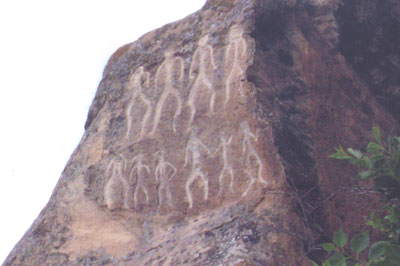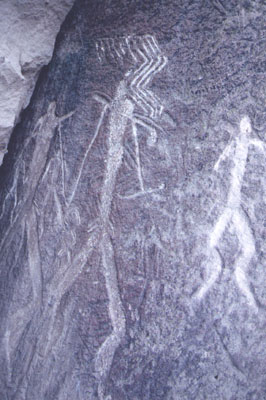Transcaucasus’ Azerbaijan and Georgia
This item appears on page 63 of the June 2011 issue.
by Julie Skurdenis (First of two parts)
My husband, Paul, and I journeyed through the Caucasus countries of Azerbaijan, Georgia and Armenia on a customized itinerary organized by Boston-based Kutrubes Travel (details will be in part two) in May-June 2010. Situated between the Black and Caspian seas, with one foot in Europe and the other in Asia, these three countries share the common thread of the spectacular Caucasus Mountains as well as a recent past of Soviet domination.
Each of these countries is unique. Azerbaijan is predominantly Moslem, with the majority of Azeris being Shiite Moslems. Georgia and Armenia are predominantly Christian, with religious roots extending back to the earliest days of Christianity.
We spent 16 days on a private tour of these three countries exploring as much as we could of what each had to offer. I’ve selected what I consider the top archaeological site visited in each country, adding a handful of nonarchaeological highlights.
Petroglyphs
Situated 36 miles southwest of Baku, Azerbaijan‘s booming capital city, is Qobustan, a UNESCO World Heritage Site. Now rocky, this area was lush with vegetation 12,000 years ago. Here, beside the Caspian Sea, Stone Age people lived in caves and hunted the abundant wildlife. When they weren’t hunting, they spent their time etching petroglyphs on cave walls.
The collapse of cave walls sometime in the distant past (no one knows exactly when) revealed petroglyphs hidden within. It is estimated that there are more than 6,000 in this one area, alone.
The petroglyphs — which continued to be carved here for thousands of years — offer a glimpse into the world of these early peoples. Besides the many abstract human figures, both male and female, there are animals: deer, goats, gazelles, horses, wild oxen and birds, among others.
There’s also a petroglyph of a reed boat apparently sailing toward the sun. Our guide Ramiza told us that Thor Heyerdahl suggested this petroglyph might perhaps link these early peoples of Azerbaijan to Scandinavians, since there is a great similarity between these and petroglyphs found in Norway.
It’s not easy to make out what many of the petroglyphs depict, so I recommend having a guide with you, as we did, who can point out the most interesting ones.
Our favorite outside of Baku was Sheki, on the way to the Georgian border. We stayed overnight in the atmospheric Caravanserai Hotel, with rooms around a lovely courtyard. Rooms are rustic, the bathrooms even moreso, but the garden is lovely, the perfect place for a glass of mint tea followed later by dinner al fresco.
We had only four nights in Azerbaijan, three of them spent in the superb boutique Sultan Inn in Baku‘s Old Town. Our favorite places were centered in the Old Town and included 15th-century Shirvanshah Palace, where dozens of 13th-century stone carvings retrieved from the Caspian Sea line one of the courtyards; 12th-century Maiden’s Tower, a unique 105-foot-tall fortress tower which has become the symbol of Baku; old caravanserais now reincarnated as rug shops or teahouses, and the Bulvar Promenade beside the Caspian.
Best of all in the Old Town was dining outdoors each night in the expensive rooftop restaurant of the Sultan Inn, watching the sun set behind Maiden’s Tower and sink into the Caspian Sea. Dinners averaged about $93 for two, including food and drinks.
Caravanserai
To cap it off after dinner, we whiled away a few hours smoking a narghile (water pipe) and lounging on plush cushions like khans. It was one of the highlights of the Azerbaijan portion of our trip.
In Georgia we visited two cave cities, Uplistsikhe and Vardzia. Separated in time by some 2,000 years (Uplistsikhe dates from about 1000 BC and Vardzia from the 12th century AD), both are extensive cave complexes hewn from solid rock.
Cave cities
Uplistsikhe, located six miles east of Gori, birthplace of Joseph Stalin, was once close to a major caravan route between Asia and Europe (hence its importance) but was destroyed by the Mongols in AD 1240.
Many of the cave rooms have eroded or collapsed, but it is still possible to visit pre-Christian temples dotting the site as well as a 10th-century Christian church built over a pagan temple.
Visitors should know that getting around the ruins is not easy; it’s uphill and there are few cleared paths. I’m not much of a mountain goat but was able to scramble over rocks with help from both Paul and our guide Thea.
Vardzia, located in southwest Georgia, developed in the 12th century AD as a monastic complex. As many as 2,000 monks once lived in rooms cut out of the rock face. There were a dozen small churches as well as the larger Church of the Assumption in the center of the cave complex. Frescoes can still be seen on the rock surfaces of this church.
As with Uplistsikhe, it can be a bit difficult to visit, since climbing is necessary, but it’s not impossible. There is a pathway, making it much easier than at Uplistsikhe.
We had seven nights in Georgia, not nearly enough to explore this spectacularly beautiful country dominated by the snow-covered peaks — even in early June — of the Caucasus.
Other highlights
Highlights, besides the mountains, included Tbilisi’s Old Town with Narikala Fortress looming over it, the two UNESCO World Heritage Sites at Mtskheta (sixth-century Jvari Church and 11th-century Svetitskhoveli Cathedral) and at Kutaisi (11th-century Bagrati and 12th-century Gelati Cathedrals) and the truly spectacular setting of Gergeti Church high up in the mountains (7,161 feet) above Kazbegi. Mt. Kazbegi (16,655 feet) looms over both the village and the church.
Add to this list the view from our room (No. 416) at the Tiflis Palace Hotel. It was mesmerizingly beautiful, especially just after sunset, with churches and Narikala Fortress spread out all around us as well as a television tower that sparkled with moving lights from sunset until well past midnight (and reminded me of the lighting effects at the Eiffel Tower).
The same view can be enjoyed from the hotel’s multilevel rooftop restaurant, where we dined every night of our three-night stay. Our dinners averaged $63 for two, including food and drinks.
Next month, Armenia plus Istanbul!



